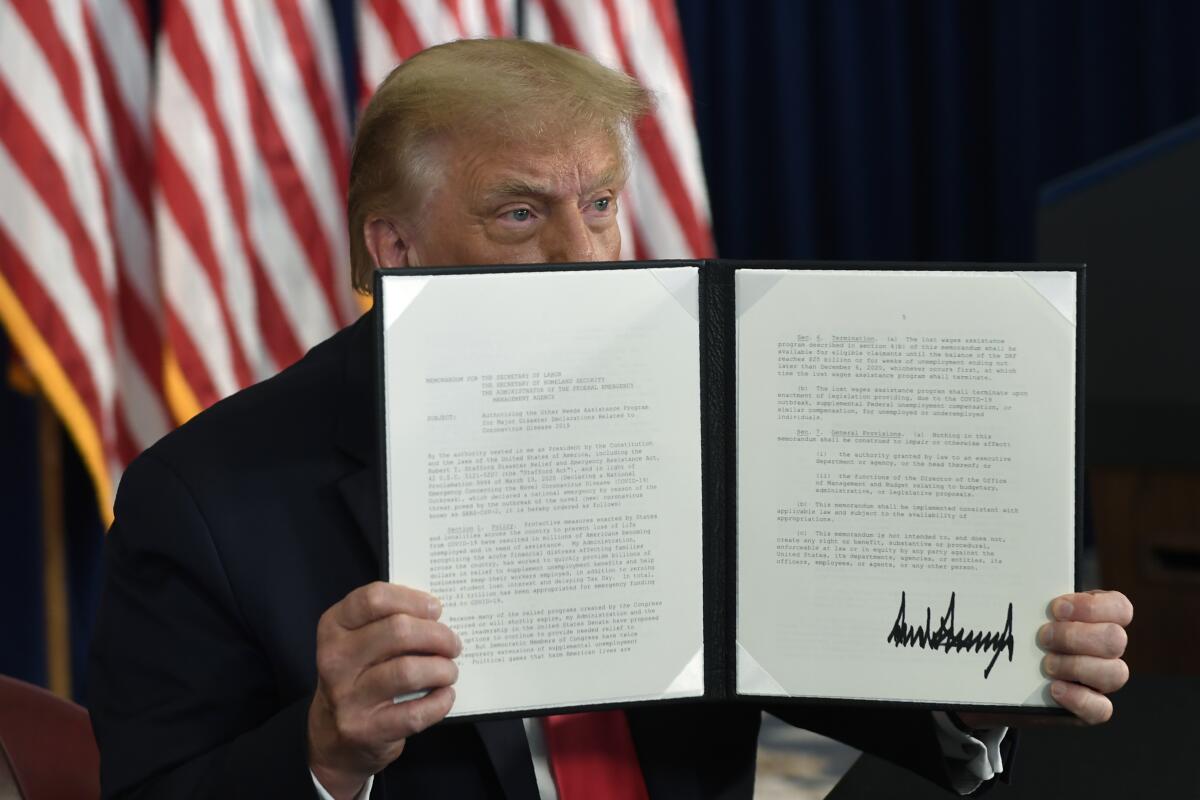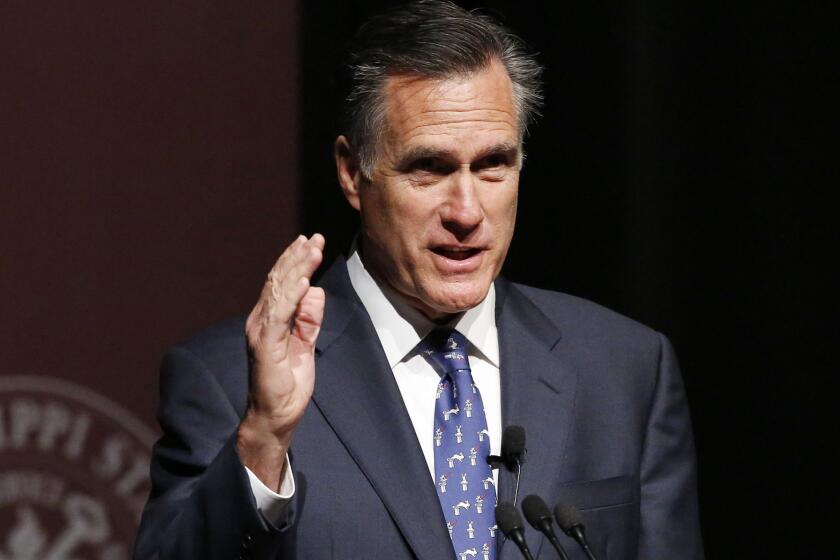Column: Following order on payroll tax, Trump threatens to kill Social Security if reelected

- Share via
With his four executive orders purportedly aimed at relieving Americans of the burdens of the coronavirus, President Trump spun the theme of his administration — “the Art of the Con” — to a higher level.
The orders he signed Saturday include a supposed moratorium on evictions and foreclosures, a deferral of student loan payments and an extension of federal unemployment benefits.
The moratorium is unlikely to stop a single eviction or foreclosure, however. The deferral of student loan payments is short-term and narrower than what Congress put in place in May, and that has expired.
This is all a very well-thought-out campaign to undermine Social Security and Medicare.
— William F. Arnone, National Academy of Social Insurance
The extension of unemployment benefits reduces the federal share to $300 a week from $600, will last only four to six weeks and imposes insurmountable barriers on states to achieve even that much.
But the most potentially far-reaching order concerns the payroll tax, which funds Social Security and part of Medicare. This order, along with comments Trump made at the signing ceremony, poses a mortal threat to the 64 million Americans who currently receive Social Security benefits and the hundreds of millions more who will receive benefits in coming decades.
If he’s reelected, Trump said, he will “terminate” the payroll tax. Make no mistake: He’s talking about bankrupting Social Security.
It’s rare that a president has made such a compelling case for his own electoral defeat. Yet his campaign was so proud of this threat that it tweeted out Trump’s words within minutes.
Social Security advocates weren’t nearly so sanguine.
“This is all a very well-thought-out campaign to undermine Social Security and Medicare,” William F. Arnone, chief executive of the National Academy of Social Insurance, told me. The order threatens to “erode the economic security of millions of Americans, without bringing meaningful relief for unemployed workers or employers.”
Rep. John B. Larson (D-Conn.), the sponsor of a proposal to expand Social Security, called the order “the single worst way to get relief to beleaguered Americans ... stealing from their retirement to make up for the administration’s failure to contain the virus.”
He’s right. We’ve written before that cutting or deferring the payroll tax does almost nothing for the vast majority of working Americans, not to mention those out of work; would overwhelmingly benefit the rich; and would knock the key source of financing out from under Social Security while opening the door to massive benefit cuts.
Trump’s executive order boasts of being a “modest, targeted action.” It’s anything but. The order says it will “put money directly in the pockets of American workers ... right when the money is needed most.” It won’t do that.
Trump nevertheless has been obsessed with the idea of a payroll tax cut, for reasons that are impossible to comprehend. One might not have thought this possible, but his executive order makes things even worse.
The most incisive line about the order belongs to Nobel economist Paul Krugman, who tweeted that “payroll tax cuts are the hydroxychloroquine of economic policy. They won’t do anything to solve the employment crisis, but will have dangerous side effects.”
Social Security advocates are universally opposed to the measure, which they see as an expression of longtime conservative hostility to the program.
Trump has been obsessed with cutting the payroll tax since the dawn of his presidency. But in his latest attack, he may be working from a strategy crafted by Stephen Moore, a right-wing economic advisor whose hostility to Social Security is manifest.
Moore laid out the payroll tax plan in an Aug. 2 op-ed in the Wall Street Journal. Moore said the president should “instruct the Treasury to stop withholding payroll taxes,” though it’s not the Treasury but employers who do the withholding. (More on that below.) But then again, being right isn’t necessarily part of Moore’s credentials.
To better understand the dire implications of Trump’s order, let’s take a closer look.
If you happened to check out the latest ranking of states for their “economic outlook” published last week by the right-wing political group ALEC, you would be excused for concluding that California is deep in an economic hole and digging itself deeper.
As a foundation, keep in mind that the payroll tax comes to 12.4% of wage income up to an inflation-adjusted cap — this year, $137,700. The tax is evenly split between employees and employers, who must pay their 6.2% share and also withhold the employee share from their paychecks and pay it over to the Treasury.
Another 2.9% of payroll, uncapped, is also shared between employer and worker to fund part of Medicare.
The centerpiece of the executive order is an interest- and penalty-free deferral of payroll taxes for four months, from Sept. 1 through Dec. 31. This is tantamount to an interest-free loan to workers of up to four months. After that period, the deferred tax will have to be paid.
Social Security experts say deferring the tax payments falls within Trump’s authority. But if he remains president and moves to eliminate the accrued debt, that can’t be done without the assent of Congress.
The terms of the deferral place a huge administrative burden on employers, whether big or small. The order applies only to workers earning less than $104,000 a year, or $4,000 per biweekly pay period. Employers will have to determine which workers fall within that zone, possibly recalculating every two weeks.
How the deferral is supposed to work in practice is murky. Under federal law, employers are required to withhold the payroll tax from paychecks. Nothing in the executive order changes that, despite Moore’s proposal. So several outcomes are possible.
One is that employers will continue to withhold the tax from workers — placing the amount equal to the deferral in escrow or paying it over to the Treasury and claiming a refund to be passed back to employees after Dec. 31.
As Seth Hanlon, a former economist for the Obama administration, observes, in that case, the order provides employers with an interest-free loan of up to four months. Meanwhile, workers won’t see a penny more in their paychecks.
Another is that they will cease withholding the tax for those four months. That places a burden, however, on workers, since the tax isn’t eliminated, just deferred. They’d likely have to pay the tax with their annual tax filings next April 15. The risk here is that many workers won’t adjust their spending to cover the obligation.
For a worker earning $60,000 a year, the deferral comes to less than $100 a week. That may help a truly strapped family (though it would be better for that household to receive assistance in a lump sum). But at the end of the year, the family will owe $1,530. That may come as quite the shock.
Then there’s the cutoff of deferrals for anyone earning $104,000 or more. Those whose employers have ceased withholding face a sheer cliff in take-home pay: Earn $103,999, you get the deferral — in effect, a temporary, repayable 7.65% bump in the paycheck. Earn a dollar more, you don’t.
Trump plainly sees this stunt as a way to blame Democrats for that tax bill, not to mention the apparent tax increase when the deferral ends and payroll taxes revert to their full level. Democrats “will have the option of raising everybody’s taxes and taking this away,” he said at the signing ceremony.
In other words, he’s offering voters a bribe — in effect, “elect them, and you’ll have to pay what you owe; elect me, and you’ll get a pass.” This raises cynicism to an electoral principle, but it’s fair to wonder if the American voter is dumb enough to fall for it.
The most frightening aspect of the payroll tax order is its impact on Social Security itself. The payroll tax is the program’s single largest revenue source. It’s been tampered with before, notably when congressional Republicans forced Obama to accept a temporary cut of two percentage points in the payroll tax as a stimulus measure. As we’ve reported, that wasn’t a great idea, but the administration was backed into a wall by a GOP majority.
But even then, the cut was accompanied by an explicit arrangement to make up the revenue loss to Social Security from the general fund. The Treasury made good on that promise, paying more than $225 billion into Social Security from 2010 through 2015.
But there’s no such backstop in Trump’s executive order. By my calculations, based on the system’s 2019 revenue and income for 2020 as projected by the Social Security trustees, the four-month deferral will deprive the system of nearly $333 billion in real-time income. Even if the money is ultimately repaid, Social Security will have lost an estimated $9 billion in interest on that revenue, permanently.
More permanent would be the impact on the system if Trump is reelected and eliminates the payroll tax. In that case, said Nancy Altman, president of the advocacy group Social Security Works, the Social Security trust fund, which currently holds $2.9 trillion in assets, would be completely depleted within four years.
Recent rulings from the Trump administration double down on cruel policies related to the coronavirus outbreak.
“There would be no contributions coming in and no interest on the trust fund because it would have been drawn down,” she said. “There would be no money to pay benefits. The whole program would just shut down.”
No one need guess what would happen to Social Security if it’s transformed from a program with its own independent revenue sources into one dependent on appropriations by Congress. The evidence from other such programs — food stamps, Temporary Assistance for Needy Families and, indeed, unemployment benefits — is in front of our eyes: Benefits can be slashed by congressional whim and the programs disemboweled.
This is all the consequence of having “a completely lawless, corrupt president in the White House, and Republicans not checking him,” Altman said. Indeed, in a statement about the executive orders, Senate Majority Leader Mitch McConnell (R-Ky.) said he was “glad that President Trump is proving that while Democrats use laid-off workers as political pawns, Republicans will actually look out for them.”
Has he even read the executive orders? And if so, how could he make such an absurd statement? Or is he just falling for the con?
More to Read
Inside the business of entertainment
The Wide Shot brings you news, analysis and insights on everything from streaming wars to production — and what it all means for the future.
You may occasionally receive promotional content from the Los Angeles Times.














